
Mammals Around Las Vegas, Wildlife Around Las Vegas
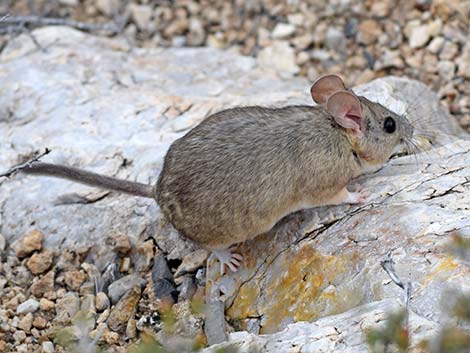 Desert Woodrat |
Desert Woodrats (Neotoma lepida), also called Packrats and Trade-Rats, are cute little creatures with big ears, big black eyes, buffy-tan fur, and very long whiskers. Around Las Vegas area, this is the only species of woodrat. Desert Woodrats are medium-sized rodents with a body length of about 6-1/2 in and a tail length to about 5 in when all stretched out. The pelage is relatively long and soft. Pelage ranges in color from buffy gray to dark gray and (rarely) black, sometimes with cinnamon and often matching the ground color where they live. The underparts are white including the throat, but the base of the throat hairs is dark. The feet are white above and naked below. The tail is bi-colored (darker over lighter) and covered with short (6 mm) hairs. The ears are relatively large, about 1-in long, and lightly haired. Fresh out of the nest, pups are dark gray. This species lives at almost all elevations in the deserts and mountains around Las Vegas. They occur from the Lower Sonoran (Creosote-Bursage Flats) Life Zone up to at least 9,000 feet in the Canadian (Pine-Fir Forest) Life Zone. Look for them anywhere -- but don't expect to see one because they are secretive and come out at night. Rarely, one might be seen during daylight, perhaps because a snake or some other predator is investigating their underground nest. |
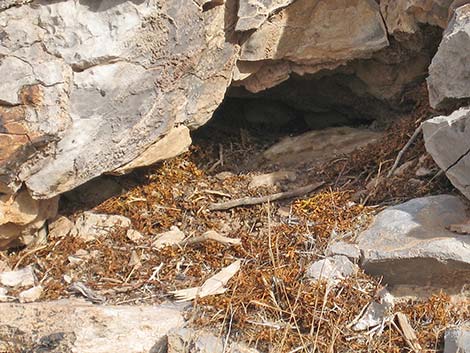 Desert Woodrat nest in a rock crevice |
Called Woodrats, Packrats, and even "Trade-rats," these creatures are known for picking up shiny objects around camps and rural residences and taking them home to adorn their nest. If a woodrat has a nut or something in its mouth, it may drop that item and pick up the shiny new thing -- hence the name "trade-rat." Woodrats armor their nest with stones, sticks, and cactus spines. They also bring home leaves, shiny things, bones, and other stuff to adorn their nest. When woodrats nest in caves, the stuff can build up for years and even centuries. Woodrats do have one disgusting habit, they poop and pee on everything, and their urine is very sticky -- almost like latex. The poop, pee, and stuff they bring in can build up and harden into a solid mass called a midden. A "midden" or "midden pile" is a fancy name for a trash heap. When ancient people made middens, they left behind things for archaeologists to dig through. From the trash, archaeologists determine how the ancients lived, what they used for tools, and what they ate. When packrats make midden piles, which are mostly solidified urine, feces, and plant material, biologists can dig through the midden to determine the same things. Photos of packrat middens. |
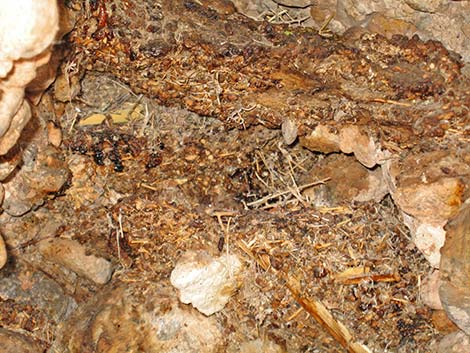 Desert Woodrat midden: note the layers of feces and plant debris |
Scientists use packrat middens to study climate change by excavating the middens and identifying plant fragments in the layers. Different species of plants grow under different climate conditions, so using the plant pieces and carbon-14 dating, scientists can determine when the plants were alive, and thereby date the changes in climate. Using midden piles from the Las Vegas area, biologists have determined that much of our desert was covered with pinyon pines and juniper trees at the end of the last ice age (about 10,000 years ago). So, the next time you see a packrat midden, take a moment and contemplate its age, but leave it alone, and thank the packrats for their contribution to our knowledge of the changing desert ecosystem. Woodrats prefer to build nests in caves and deep cracks in cliffs where predators can't dig them out, places such as this little cave (photo at left). In addition to the protection afforded by the cliffs, woodrats armor their nest with bits of sticks, leaves, stones, and cactus spines to keep predators out. Although woodrats prefer to build nests in rocks and caves, they are quite resourceful and will use a variety of nesting places if necessary. For more examples of woodrat nests, click here. |
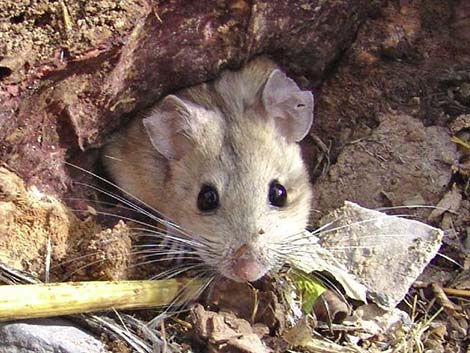 |
If you were a tasty bug or a juicy leaf, this might be the last face you ever see! |
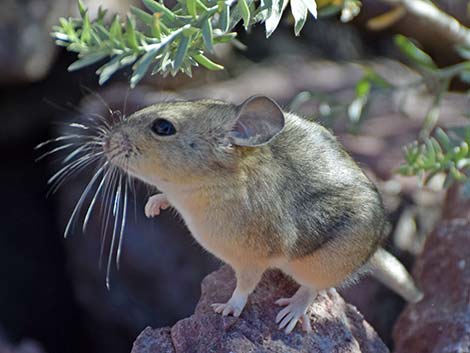 |
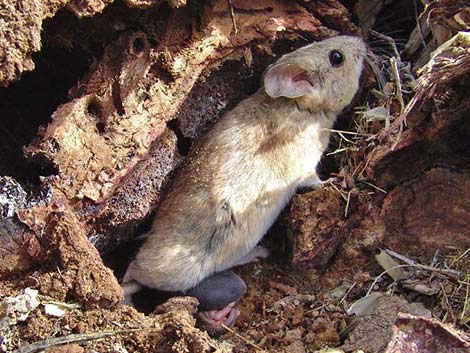 |
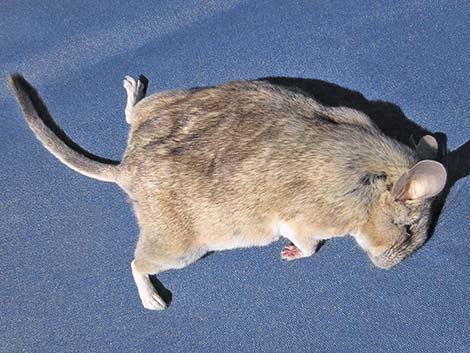 Pale gray-brown back; tail with short hairs throughout. Roadkill |
 Big ears and very long whiskers. Adult male. Roadkill |
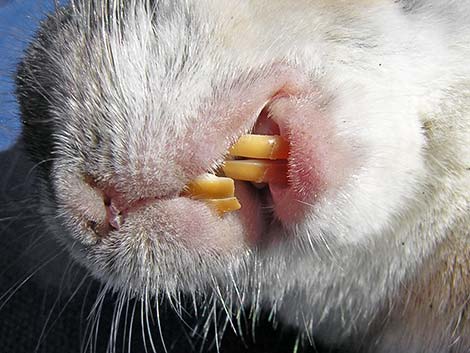 Typical rodent incisors. Adult male. Roadkill |
 Pale white belly. Adult male. Roadkill |
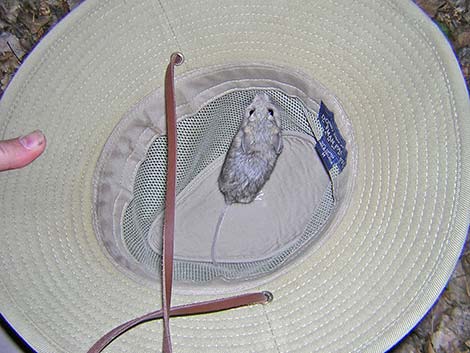 Juvenile Desert Woodrat |
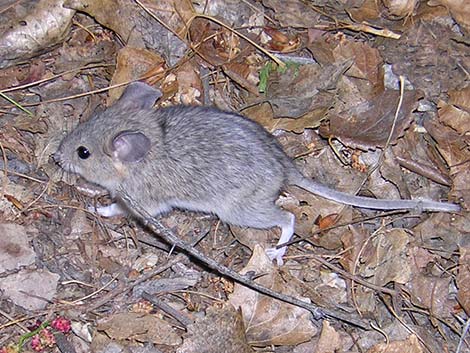 Juvenile Desert Woodrat |
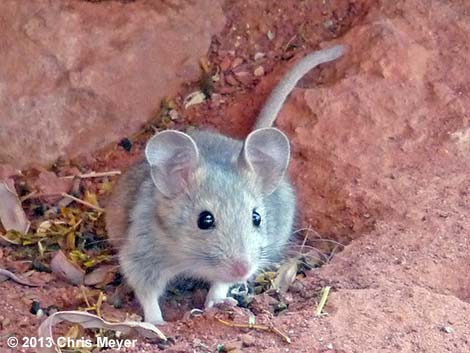 Juvenile Desert Woodrat |
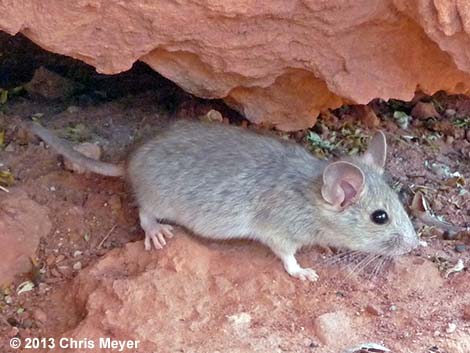 Juvenile Desert Woodrat |
 Desert Woodrat on an Eastern Joshua Tree stump |
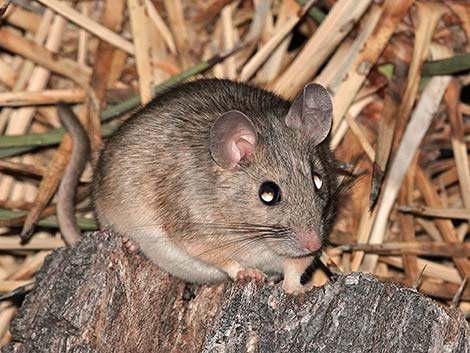 Desert Woodrat on an Eastern Joshua Tree stump |
Note: All distances, elevations, and other facts are approximate.
![]() ; Last updated 250131
; Last updated 250131
| Mammals Around Las Vegas | Wildlife Around Las Vegas | Glossary | Copyright, Conditions, Disclaimer | Home |